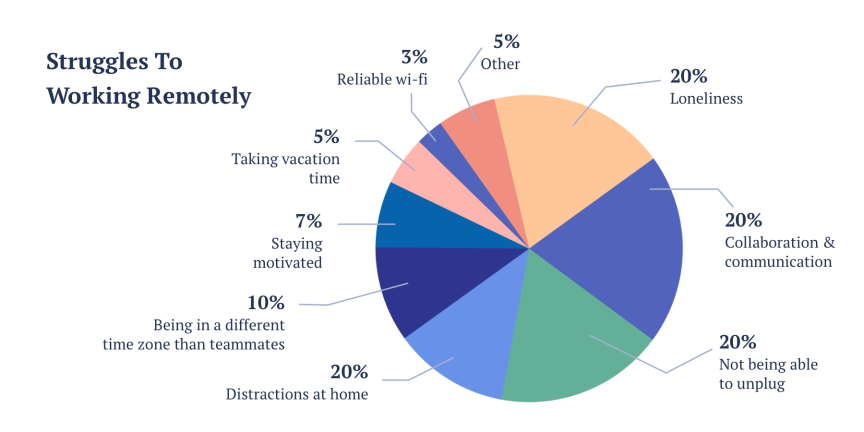Learn why leading HR professionals trust ekincare! Explore Now

To reduce the spread of COVID-19, millions of employees worldwide began working from home. Recently, Mark Barrenechea, CEO - OpenText, estimated that up to 300 million people switched to teleworking at the start of the pandemic.
As governments continue rolling out stronger measures to address the spread, this new way of working comes alongside broader isolation protocols preventing social contact with friends and extended family and has caused a ripple effect of loneliness for millions of people in every sector of the workforce. No one is immune from the feelings of isolation that this contagion has caused and when loneliness becomes a chronic experience, it can harm our health and well-being.

One of the challenges of self-isolating and remote working is managing loneliness, which is indeed a growing problem among workers these days and as organizations adapt to create policies supporting the movement to a remote workforce, they too need to prepare to support employees’ needs for social interaction and community.
At a time when organizations need their employees to come together and adapt to a truly unique set of circumstances, it’s equally important to take these steps to reduce any risk factors for isolation upfront.
One of the most common sources of frustration and resulting isolation for remote workers is a lack of access to the materials or platforms needed to perform their roles. This can result in staff feeling ‘unimportant’, or as though their needs aren’t valued.
Employers should ensure that their storage solutions have all vital documentation, address accessibility, and other permission issues and create a feedback loop to identify any gaps or issues. Also email alone is insufficient. Remote workers benefit from technology, such as video conferencing, that gives participants many of the visual cues that they would have if they were face-to-face.
Keeping staff in the loop is more important than ever before.
Uncertainty can perpetuate feelings of isolation or disconnect. Remote workers tend to increasingly lose a sense of connection to their organization unless employers proactively nurture it. Employees need to understand what’s happening in the big picture of their organization.
Employers need to ensure that they are giving regular top-down communication outlining business continuity plans and celebrating business achievements – or even simple shows of resilience. Any regular business rituals, such as senior leadership updates can be replicated whenever possible as virtual town halls, blogs, or vlogs.
Widespread home working often results in silos: Individual departments or project teams operating in a virtual bubble, unseen by the rest of the organization. For individuals and teams alike, the result can be a sense of being cast adrift.
Set managers and leaders should take up this task of actively promoting what their teams are doing. This may be a weekly team roundup or a general ‘what’s happening’ session regularly to rotate around the different departments and projects in the organization.
The benefit is two-fold: Those involved in the highlighted projects feel seen and those hearing about the different things happening will benefit from a better sense of awareness and connection to their colleagues and business.
Recognition and appreciation correlate to increased productivity, morale, engagement and outcomes any organization needs now more than ever.
When working from home, much of the effort of employees takes place behind the scenes, unseen by others. Everyday appreciation can easily be lost in the now noisy digital workplace.
Creating a company-wide culture of recognition means bringing those single, hidden moments into the open.
Consider a nomination system where line managers or even employees can put forward individuals for a shout-out in senior leadership comms. Reinforcing the importance of recognizing employees by a simple ‘thank you’ can go a long way.
Not having visibility of the tasks, projects, and work that is going on can be a trigger for isolation. It results in lost opportunity for those who have something to contribute, potential duplication of effort, and generally feeling ‘out the loop.’
Digital tools such as Asana or Microsoft Teams Planner can be used to map out individuals, teams, and project tasks for smoother management of workload from a distance. Giving teams access will provide much-needed insight and connection to what’s happening for individual employees. Back this up with a regular virtual team or project ‘stand-ups’: a brief update on what people are working on can shed light on potential challenges or areas where others can put forward their ideas or skills.
Isolation can also occur when individuals feel overlooked when work takes place that they could contribute to, or when their skills are being under-utilized. Long-term, this leads to discontent as employees feel they aren’t being developed or sufficiently ‘challenged.’
This tends to be a more significant issue for single remote workers who don’t get that much-needed face time with their peers to build their professional networks. However, without chance conversations or the simplicity of walking over to an individuals’ desk, there’s a risk that the remote teams will start to see a similar effect.
One way is to task project owners with mapping out not individuals, but the skills and expertise required when setting out work.
Now we’re no longer physically sitting with our teams, it may be an ideal opportunity to try a more collaborative, agile way of working and unearth hidden, under-utilized talent across the organization.
One of the challenges employees might be seeing is difficulty engaging those individuals who are naturally introverted and maybe less proactive in reaching out to others or participating in virtual spaces and conversation. It’s a trait that becomes amplified when working alone.
Peer pairing may be an option in this scenario; designating a more extroverted personality to check-in or informally chat with those who have a higher risk of slipping under the radar. Managers must also take proactive responsibility for reaching out to those individuals, setting a daily one-to-one check-in, and using video will give them much-needed face time, even if they’re reluctant.
Encourage all your employees to be kind to one another. Create a weekly hashtag to capture and share your team's gestures with the organization to help them feel connected to people outside their own teams also.
Create a private Facebook group for your team to stay connected. Encourage them to share pictures, recipes, emotions, and daily experience/learning while working from home.
Battling loneliness and chronic stress even in normal times can be exhausting. As today's employees face additional stress and isolation, leaders can do their part by finding novel and positive ways to create connections. By checking in and setting up spaces for workers to collaborate and connect, leaders demonstrate that employee well-being is top of mind.
Read more to know about ekincare's Mental Wellbeing And Stress Management Program.